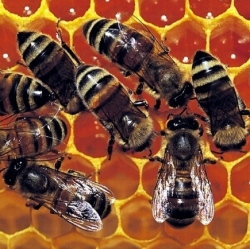
When HIV jumped from chimpanzees to humans sometime in the early 1900s, it crossed a gulf spanning several million years of evolution. But tobacco ringspot virus, scientists announced last week, has made a jump that defies credulity. It has crossed a yawning chasm ~1.6 billion years wide.
And this is likely bad news for its new host, the honeybee, matchmaker of crops and bringer of honey. These are two services for which humans are both eternally indebted, and, in the case of the former, possibly unable to live without. Bees pollinate the majority of our fruit and nut crops and many vegetables, some 90 all told, without which humanity would be nutritionally impoverished.
Yet shortages are a possibility we are confronting, as bee populations in America have declined in recent years for reasons that seem to be both diverse and elusive. Colony collapse disorder, as whatever it is is called, was first reported in 2006 and has spread globally. Many viruses, parasites, and pesticides have been implicated, but no smoking gun has emerged.
As scientists were studying the possible role of pollen in spreading known bee viruses, a team of scientists from the United States and China began screening bees and pollen for viruses of all sorts. To their surprise, as they reported Jan. 21 in the journal mBio, they discovered a common plant virus, tobacco ringspot virus, had seemingly infested honeybees. Was it merely a transient visitor? Or had it made itself at home in a place inconceivably different from its usual digs?
Their first clue was the virus’s genome. Tobacco ringspot virus is an RNA virus. Though DNA acts as a stable repository of instructions for building proteins, RNA is how that information is transmitted to the part of the cell that manufactures them. It is transient by nature, and recycled after a short time. As a result, RNA polymerase, the enzyme that makes RNA by copying DNA, is not as careful as DNA polymerase, the enzyme that replicates it.
It lacks a key proofreading mechanism that DNA polymerase has (3′->5′ proofreading), and as a result, is more likely to make mistakes called mutations. In humans, that is not a problem, because the life of an individual strand of RNA is brief and any mistakes end with its destruction.
